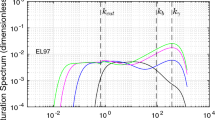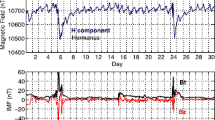Abstract
The equatorial wave campaign-II which formed a part of the Indian Middle Atmosphere Programme (IMAP), was conducted from SHAR (13.7°N, 80.2°E) from 15 January to 28 February 1986. Winds were measured from ground to 60 km by means of high altitude balloon and a meteorological rocket (RH-200), once everyday, for 45 days. The frequencies of the oscillations in the deviations of the east-west component of the winds from its mean at each height with one kilometer interval were obtained by the maximum entropy (ME) method and phases/amplitudes of these frequencies were determined by the least squares technique on the wind variation time series. The ME method has the inherent advantage of providing periodicities up to 1.5 times the data length.
The height structure of the long period waves of > 23 day periodicities that have larger amplitudes nearly by a factor of 2 as compared to the medium (9 to 22 day) or shorter period (4 to 8 day) ones, reveal two height regions of enhanced amplitudes, one in the troposphere and another in the upper stratosphere/lower mesosphere, that too, mostly in the regions of positive (westerly increasing or easterly decreasing with height) wind shears. The waves are seen to be inhibited in the negative wind shear regions. From the abrupt changes in the altitude variation of phase, the possible source region has been identified. The vertical wavelengths have been estimated to be 34 km and 19 km in the troposphere and lower stratosphere respectively and 8 km in the upper stratosphere and lower mesosphere. Around 56 km the wave amplitude is reduced to 1/4 of its value below, while the vertical shear strength in the mean wind doubled up. The tropospheric waves are suggested to be Rossby waves of extratropical origin penetrating to tropical latitudes. The stratospheric/mesospheric waves however appear to emanate from a source around the stratopause.
Similar content being viewed by others
References
Blackman R B and Tukey J W 1958Measurement of power spectra from the point of view of communications engineering (New York: Dover)
Burg J P 1967 Maximum entropy spectral analysis;Paper presented in the 37th meeting Soc. Explor. Geophys., New Orleans
Burg J P 1970 New concepts in power spectra estimation;Paper presented in 40th meeting Soc. Explor. Geophys., New Orleans
Chen T C 1987 30-50 Day Oscillation of 200-mb Temperature and 850-mb height during the 1979 Northern Summer;Mon. Weather Rev. 115 1569–1605
Fougere P S 1977 A solution to the problem of spontaneous line splitting in maximum entropy power spectrum analysis;J. Geophys. Res. 82 1051–1054
Gao X H and Stanford J L 1987 Low frequency oscillations of the large-scale stratospheric temperature field;J. Atmos. Sci. 44 1991–2000
Hirota I 1979 Kelvin waves in the equatorial middle atmosphere observed by the Nimbus 5 SCR;J. Atmos. Sci. 36 217–222
Holton J R 1975 The Dynamic Meteorology of the Stratosphere and Mesosphere;Meteor. Monogr. 37 (Amer. Meteor. Soc.)
Jones R H 1965 A reappraisal of the periodogram in spectral analysis;Technometrics 7 531–542
Krishnamurthy B V, Indukumar S, Raghava Reddi C, Raghavarao R and Rama G V 1986 Results of equatorial wave campaign of IMAP in May–June 1984;Indian Radio Space Phys. 15 125–138
Lacoss R T 1971 Data adaptive spectral analysis methods;Geophysics 36 661–675
Madden R A and Julian P R 1971 Detection of a 40–50 day oscillation in the zonal wind in the tropical Pacific;J. Atmos. Sci. 28 702–708
Madden R A and Julian P R 1972 Description of global-scale circulation cells in the tropics with a 40–50 day period;J. Atmos. Sci. 29 1109–1123
Radoski H R, Fougere P S and Zawalick E J 1975 A comparison of power spectral estimate and application of the maximum entropy method;J. Geophys. Res. 80 619–625
Radoski H R, Zawalick E J and Fougere P S 1976 The superiority of maximum entropy power spectrum techniques applied to geomagnetic micro pulsations;Phys. Earth Planet. Int. 12 208
Sikka D R and Gadgil S 1980 On the maximum cloud zone and the ITCZ over Indian longitudes during South west monsoon;Mon. Weather Rev. 108 1840–1853
Smylie D E, Clarke G K S, Ulrych T J 1973 Analysis of irregularities in the earth’s rotation;Meth. Comput. Phys. 13 391–430
Ulrych T J 1972 Maximum entropy power spectrum of truncated sinusoids;J. Geophys. Res. 77 1396–1400
Ulrych T J and Bishop 1975 Maximum entropy spectral analysis and auto regressive decomposition;Rev. Geophys. Space. Phys. 13 183–200
Wallace J M 1971 Spectral studies of tropospheric wave disturbances in the tropical western Pacific;Rev. Geophys. Space. Phys. 9 557–612
Webester P J 1983 Large-scale structure of the tropical atmospheres;Large scale dynamical process in the atmospheres (ed) B J Hoskins and R P Pearce (London: Academic Press) pp. 235–275
Webester P J and Chang H R 1988 Equatorial energy accumulation and emanation regions: Impacts of a zonally varying basic state;J. Atmos. Sci. 45 803–829
Webester P J and Holton J R 1982 Cross equatorial response to mid latitude forcing in a zonally varying basic state;J. Atmos. Sci. 39 722–733
Yasunari T 1981 Structure of an Indian summer monsoon system with around 40 day period;J. Meteor. Soc. Jpn. 59 336–354
Zhang C and Webester P J 1989 Effects of zonal flows on equatorially trapped waves;J. Atmos. Sci. 46 3632–3652
Author information
Authors and Affiliations
Rights and permissions
About this article
Cite this article
Raghavarao, R., Suhasini, R., Sridharan, R. et al. Vertical structure and characteristics of 23–60 day (zonal) oscillations over the tropical latitudes during the winter months of 1986 — Results of equatorial wave campaign—II. Proc. Indian Acad. Sci. (Earth Planet Sci.) 99, 413–423 (1990). https://doi.org/10.1007/BF02841869
Received:
Revised:
Issue Date:
DOI: https://doi.org/10.1007/BF02841869




